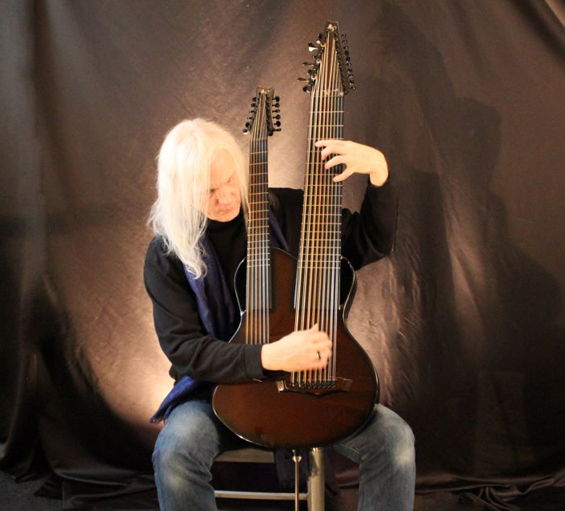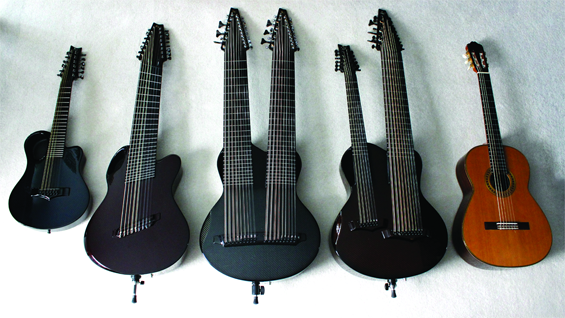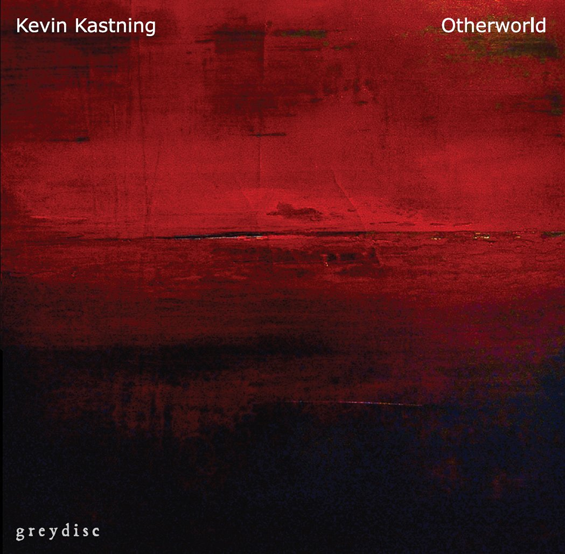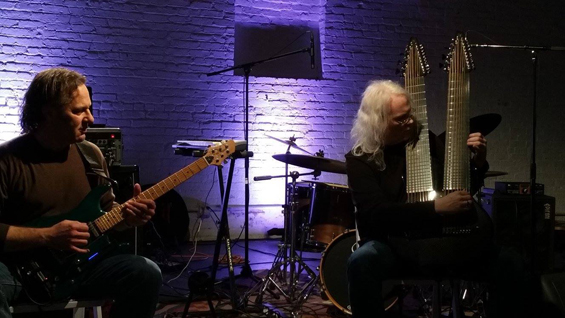Articles
2015 Artists' Picks
Kevin Kastning
Andy Vaz's House Warming
Albums
17 Pygmies
Aaltonen & Haarla
Rodolphe Alexis
Arca
Autistici
Marc Barreca
Le Berger
Book of Air
Cicada
David Cordero
Council of Nine
DBR UK
En
Green Isac Orchestra
Anders Lønne Grønseth
Hatakeyama + Serries
Heinen & Borring
William Hooker Quartet
How To Cure Our Soul
Kevin Kastning
Kastning / Clements
Kastning / Szabó
Kastning / Wingfield
Library Tapes
loadbang
Louis Minus XVI
Rhys Marsh
Palmbomen II
Radare
sleepland
Smith & Lindberg
Robert Stillman
tholl / fogel / hoff
Julia Wolfe
Wordclock
CD/DVD/Photobook
Kosemura, Shinozaki, Nitta
Compilations / Mixes / Remixes / Reissues
Collection 100
Landscapes of Fear
EPs / Cassettes / Mini-Albums / Singles
Akuratyde
Amonism + Revenant Sea
anthéne
Matt Barbier
Conduct
Hesperius Draco
Martsman
Markus Oehlen
Greg Sawyer

TEN QUESTIONS WITH KEVIN KASTNING
When I recently reviewed six of Kevin Kastning's albums (read the textura review here), I couldn't help but wonder why one of his most recent releases, Otherworld (issued on his own Greydisc Records imprint), also happened to be his first purely solo album, especially when such a large number of collaborative albums had come before it. That turned out to be merely one of the questions I put to the guitar innovator and current northern Massachusetts resident during an in-depth interview, with others pertaining to the musical partnerships he's formed with fellow guitarist Mark Wingfield, bassist Michael Manring, and woodwinds player Carl Clements, his experience as a private student of Pat Metheny at Boston's Berklee College of Music, and the remarkable guitars he's invented, among them the 36-string Double Contraguitar and 30-string Contra-Soprano guitar.
1. You've released over twenty full-length albums, yet, unless I'm mistaken, your latest is the first one to feature you by yourself. That's a release pattern that inverts the customary practice of an artist releasing a solo recording before tackling collaborations. Why did you choose to wait so long before featuring yourself playing alone?
Various reasons. I didn't want to release a solo record, or embark on a series of solo recordings, until I felt that I was ready. I have been told that I'm rather demanding of myself; hence I didn't think I was ready for a long time. And for the past seven years, I've had a new instrument in development every year. With each instrument, I felt that each one was a step closer to being a true solo works instrument, but by the time that instrument arrived, the music had grown such that I was already off designing the next one, which I felt would be even better yet for solo works. Each time that happened, the solo project was delayed by a year. When the 36-string arrived, I knew it was the instrument, and I booked the studio time. Not long after I began the solo recording project, the 15-string extended classical arrived, and that further delayed the recording process, as I wanted to use it for solo works along with the 30- and 36-string, but I had to take the time to learn the instrument; ergo, another delay. Again, I have another instrument currently in development, but I've already started work on the next solo record. It will absolutely be on the solo records, but I don't want to delay the next album for the new instrument, which is a 44-string instrument.
2. To my ears, your music doesn't easily slot itself into a single genre. What's your response when someone asks, “What style of music do you play?”
I still don't know how to answer that question. If they've heard my music, I ask them into which genre they'd place it. Maybe I'm looking for clues from them! If they've not heard my music, I usually state that it's a kind of modern classical music. Which is how I think of it, or it's closer to that genre in my mind than anything else. Interestingly, it gets played on jazz, classical, new age, and even progressive rock radio stations and receives coverage in magazines from those various genres as well. So I suppose I'm not the only one who doesn't know how to categorize it. I've always been drawn to music that's arduous to categorize.

3. The guitars you've created look incredible; simply gazing upon the 30-string Contra-alto guitar and 36-string Double Contraguitar is an experience unto itself. But what compelled you to create such instruments? That is, what necessitated the invention of the 30- and 36-string models when 12- and 16-string guitars are available? And what does the production process involve to create such 30- and 36-string instruments?
All good questions, but it's almost like asking “Why bother with a symphony orchestra when string quartets are available?” Simply put, it's what is required by the music. I was composing music for instruments that didn't exist. For me, the range of a six-string guitar is very limited; a 12-string has the same range; it's just double-courses. So, as my music and compositions expanded and grew in range and register, I needed the instruments which would allow me to realize those pieces. Each instrument gets me closer and closer. But as I get the instruments closer to the existing music, the music continues to expand and the instruments must follow suit. It's a long, slow process; it may never be over.
The instrument production process usually takes between one and three years. It takes me about a year to amass the new works that don't fit any current instruments, and then crystallize what I need in an instrument because of them. There's much to consider: ranges, registers, number of strings and courses, pitches and tunings, and the resultant technical specifications: body design, nut width, bridge spread, materials, tuner type, tuner selection and their layout, customized pickup system, string gauges, cases, and on and on. Once I have the design and specifications in mind, I'll send it to the luthier; depending on the instrument, that's either Dan Roberts at Daniel Roberts Stringworks in Montana USA, or Alistair Hay at Emerald Guitars in Ireland. From there, we begin a dialogue about the design specifications and requirements, and the luthier makes recommendations or design suggestions or changes. Once we're in agreement on everything, and I'll use Alistair as an example, he'll do a full-scale mockup drawing or actual 2-D mockup and run it by me. Once we're both in full agreement and we've solved all the puzzles and problems (and there are always new challenges to solve), then work on the instrument begins. Actual build time can range between three and eight months. Alistair and Dan are as much collaborative partners in my music as are the artists with whom I record and perform, and I am very grateful for both of them.
4. You've been playing for a long time now. How have your playing and artistic sensibilities changed from your early recordings to the ones you're releasing now?
Hmmm.... I don't know if I'd say it's changed as much as it has developed, evolved, and expanded. I do know that ten or even five years ago, I couldn't have conceived of the solo works I'm doing right now. It all just keeps expanding and growing. I think I'm approaching the guitar in much more orchestral way and hearing more orchestral textures within it. If you go back to some of the early recordings with KastningSiegfried from the late ‘80s or early ‘90s, that music really has no resemblance to the work I'm doing at present.

5. Your recordings are interesting for many reasons, among them the relationship between formal composition and improvisation. To what degree is a typical Kastning piece formally composed and how much improvised?
I've been composing since I was seven or eight years old. The pieces I compose for something like string quartet and other chamber groupings are entirely 100% composed and all scored out on manuscript paper as you'd expect. The solo guitar pieces are largely improvised; sometimes based on a sketch, sometimes not. To use the new solo record, Otherworld, as an example, I had about forty pieces sketched out for it. By sketches, I mean sections are composed, but nowhere near an entire piece. To use an analogy from the painting world, think of a rough pencil sketch versus a complete oil-on-canvas painting. My sketches are between a half-page and two pages of manuscript. So, I took the sketches into the recording studio with me for the sessions that would become Otherworld , but I didn't use any of them. I ended up improvising all the pieces on that record live in the studio. It wasn't my original intent; it just worked out that way. And I've already sketched out another dozen or more pieces for the next solo project since I finished the sessions for Otherworld. Right now I have no idea if I'll use them, or if I'll again improvise the pieces in the recording studio for the next solo record.
6. Most guitarists end up playing in a band with a standard rhythm section. How did it come about that you followed the path you did, one that sees you playing sans rhythm section and either playing acoustic guitar solo or with one other musician?
There was a time when I was in a jazz phase for several years in the ‘80s wherein I had my own quartet with drums and bass. Prior to Berklee, my undergrad studies were at a classical university, studying orchestral music and that tradition, and I was composing within that genre of work. Eventually I evolved out of the jazz phase, and the music that I was writing no longer required a rhythm section and was a return to composing modern classical works. I have done two albums with the brilliant Hungarian percussionist Balazs Major, but he functions more like a textural melodic instrument than a rhythmic one; at least in my mind that's how I hear his work. In the classical world, I've composed pieces for solo instruments, duets, trios, quartets, quintets and more. But not that much for orchestra. I think I have always naturally gravitated toward smaller chamber groups and solo compositions, both in listening and composing, and that has had a tremendous impact on my guitar-world thinking, performances, and recordings. And writing for and playing the 30- and 36-string instruments feels like a small symphony orchestra to me.
7. You studied privately with Pat Metheny when you were at Berklee School of Music. What was the most valuable thing you took away from your studies with him?
I didn't study with him for very long, but it made a huge impact on me, both then and continuing through now. Certainly the most valuable lesson from Pat was about time. He got me to consider time in new ways, and I still focus on and work on that today. No doubt I always will.

8. Do you make adjustments to your playing when you're collaborating with one musician versus another? For example, did you adopt a different approach for the two recordings with Carl Clements than the approach you used for the two Mark Wingfield albums?
Entirely. I have had guys tell me that they think I sound and play entirely differently in each setting. I mean, I still sound like me, but for example, there are things I'd play with Wingfield that just wouldn't fit in the pieces I do with Carl, and vice-versa. Each project is entirely different, and I approach each one as its own setting and compositional environment. I'm just there to serve the music and try to provide whatever it requires in each setting.
9. You've collaborated with many others in addition to Clements and Wingfield. What other names are on your wish-list of future collaborators?
I've been really fortunate in that some artists I have long tremendously admired will soon be doing recording projects with me. I'm currently starting work on a record project with flugelhornist Mike Metheny and really looking forward to that. Guitarist Terje Rypdal agreed to do a duo album with me; I'll try to get that slated for this year. Cellist David Darling and I are planning to record together, and we're just trying to get our schedules to line up. Bassist Michael Manring and I have been planning another record together and that's also a matter of scheduling. I feel incredibly fortunate to be able to work with these artists. It's very humbling and also a little scary! As wish lists go, one artist with whom I'd love to work is Norwegian pianist Ketil Bjørnstad. Ketil, if you're reading this ...
10. Having developed such incredible facility on the guitar, is there anything left for you to conquer on the instrument?
Oh, my. I don't think I have anything like incredible facility, but it's very nice of you to say. I practice every day and am still very much learning the instrument. Especially with these huge instruments, I feel as if I'm only scratching the surface of them. I discover new things on them almost daily, new techniques, new harmonic possibilities, new ways of approaching each instrument that is unique to that instrument, and on and on. It never ends. I love that.
January 2016
![]()